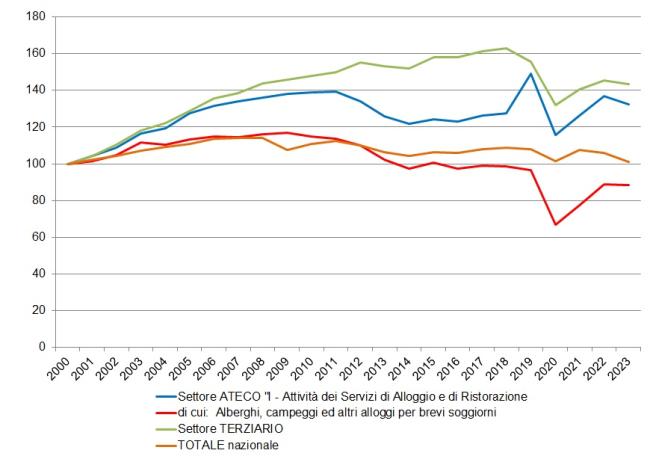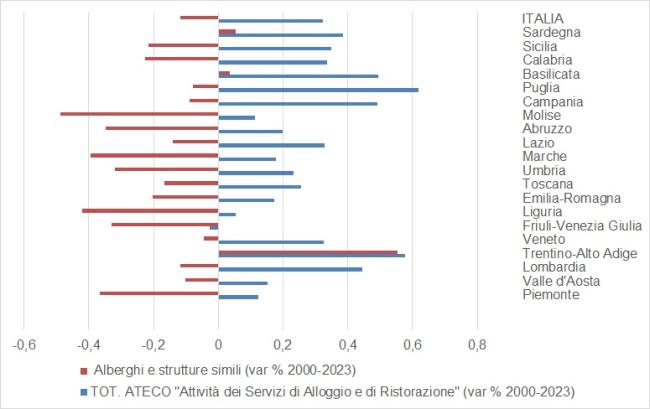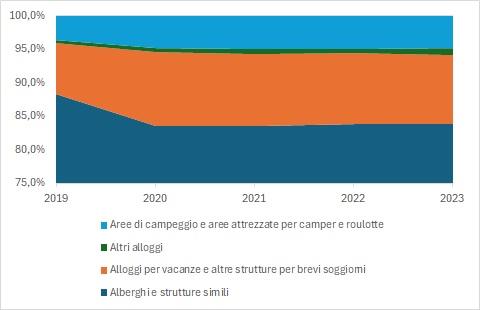Panel 1
Giovanni Finocchiaro, Silvia Iaccarino
The indicator illustrates electricity consumption in the tourism sector, identified by the ATECO category "Accommodation and Food Service Activities". In 2023, this sector accounted for 4.2% of total electricity consumption in Italy. When considering only accommodation activities—such as hotels, campsites, and other short-term lodging facilities—this share drops to 1.5%. In 2023, within the "accommodation" subcategory, 83.8% of electricity consumption was attributable to "hotels and similar establishments".
European literature on the subject (Tourism and Environment, Schmidt, 2002) identifies tourism as a factor impacting electricity consumption levels.
Although it is difficult to quantify the pressure of tourism on the environment, these European reference studies suggest a correlation between electricity consumption and tourism density—higher electricity consumption is recorded in areas with higher tourism density.
The indicator does not aim to confirm or refute this literature but simply presents:
- The electricity consumption of the ATECO category "I - Accommodation and Food Service Activities"
- Its share of total national and regional electricity consumption
To show the trend in electricity consumption for the ATECO category "I - Accommodation and Food Service Activities".
The indicator has no direct reference to specific regulations or legal obligations.
Panel 2
H.W. Schmidt, Tourism and the environment
TERNA S.p.A., Dati statistici sull’energia elettrica in Italia, anni vari
Ministero dello sviluppo economico, Bilancio Energetico Nazionale, anni vari, http://dgsaie.mise.gov.it/dgerm/ben.asphttp://www.sviluppoeconomico.gov.it
In the future, it would be desirable to obtain average electricity, water, and gas consumption data by type of accommodation facility.
Data quality assessment
Terna - National Electricity Grid S.p.A.
https://www.terna.it/it-it/sistemaelettrico/statisticheeprevisioni/datistatistici.aspx
https://www.terna.it/it/sistema-elettrico/statistiche/evoluzione-mercato-elettrico/download-center
2000-2023
National, Regional
Indicator assessment
The indicator uses electricity consumption data from TERNA, and simple ratios are calculated to determine incidence rates.
In 2023, the ATECO "Accommodation and Food Service Activities" sector contributed 4.2% of total electricity consumption in Italy. When limiting the analysis to accommodation facilities, the incidence was 1.5%. Both percentages show a slight increase compared to the previous year, suggesting an overall status classified as "medium".
Between 2000 and 2023, electricity consumption in the tourism sector grew by 32.3%. However, when focusing exclusively on accommodation facilities (hotels, campsites, and other short-term lodging facilities), an 11.7% decrease was recorded (Figure 1, Table 1).
This segment, which accounted for 34.7% of the total electricity consumption in the tourism sector in 2023, includes various high-energy-consuming activities, such as heating, air conditioning, lighting, hot water use, food preparation, swimming pool management, and other services.
At the same time, during this period, electricity consumption increased in both the tertiary sector and total national consumption.
Data
Tabella 1: Consumi di energia elettrica per il settore merceologico relativo al turismo
Elaborazione ISPRA su dati TERNA



Between 2000 and 2023, the incidence of the tourism sector within the tertiary macro-sector declined from 13.7% to 12.7% (Table 1, Figure 1). However, the overall increase in electricity consumption in the tourism sector (+32.3%) was observed at the national level.
When analyzing only the accommodation sector, a decline in electricity consumption is evident, except in some regions such as Trentino-Alto Adige, Basilicata, and Sardinia. The most significant reductions were recorded in Molise (-48%) and Liguria (-42.1%). These figures highlight tangible progress in energy efficiency within accommodation facilities (Figure 2). These results demonstrate an increasing commitment to more sustainable energy practices.
Between 2019 and 2023, electricity consumption in accommodation activities accounted for over 32% of total electricity consumption in the Accommodation and Food Service sector. Among the economic subcategories within this sector, in the same five-year period (2019-2023), "hotels and similar establishments" accounted for an average of 84.6% of electricity consumption in the "accommodation" subcategory. The highest incidence was recorded in 2019 (88.2%), compared to 83.8% in 2023. Electricity consumption in "holiday accommodations and other short-term stays" increased from 7.7% in 2019 to 10.3% in 2023, with peaks during the 2020-2021 pandemic years. During this period, tourists likely preferred isolated accommodations rather than hotels, which typically offer more shared spaces and higher bed capacity (Figure 3).